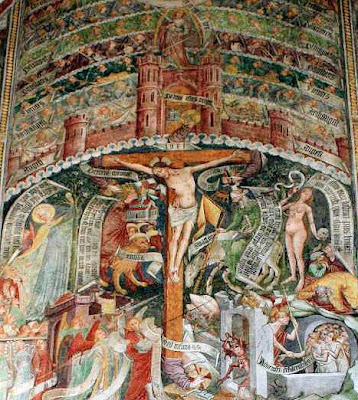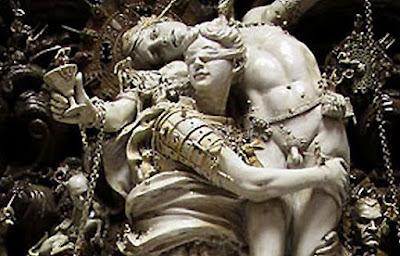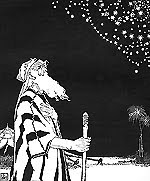In certain European paintings Jesus can be seen nailed on some sort of symbolic cross where each extreme ends in the shape of an arm taking a different action. This type of image is known as the "Living Cross" (Italian Croce briachale, German Lebendes Kreuz, French Croix vivante).

Because of the cruciform halo each of the four hands presents, the viewer is led to deduce that the actions are Christ's. According to what is often depicted, such actions are: breaking the gate of hell, unlocking the gates of paradise, crowning Christian belief and piercing the Jewish faith. Significantly the latter ideas are suggested through allegorical female figures, each with her own attributes:
- Ecclesia receives a crown on her head, while bringing a model of the church, riding the tetramorph beast (symbol of the four evangelists), and holds Christ's flag, all at once.
- Synagoga is killed by a sword, which has also hurted badly the donkey she is riding on. She has her eyes covered, to suggest blidness. In her hands she holds a broken flag and the head of a sacrificial goat.[1]
The sharp contrast between these figures has its visual referent in medieval imagery.[2] There, Ecclesia can be seen crowned and holding a chalice with Jesus' blood, and Synagoga is presented with her eyes covered a losing her crown.
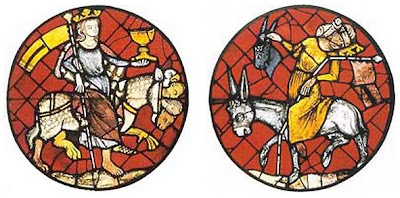
Medieval medaillons of Ecclesia et Synagoga. Gothic stained glass. Münster Cathedral, Germany

Herrade de Lansberg, "Crucifixion" from her Hortus deliciarum, Alsace, 1185-95

Ecclesia et Synagoga, Gothic stained glass, 1414-67. Johanneskirche, Werben, Germany
 This complex detail from a Graduale (Franciscan workshops in Augsburg, c. 1494-7) is an initial that belongs to the so-called "living cross" imagery. As a composition, it includes a cross that rises over a landscape and displays the body of Jesus.[3] According to the German description of Elisabeth Vavra,[4] God the Father appears on the top of the cross, with his right hand raised in a blessing gesture, and the orb on his left hand. On both sides there are angels. From each side of the cross, two female figures can be seen. The one on the left, Ecclesia rides on a tetramorph and collects the blood coming from the side wound of Christ in a chalice. From the right side, Synagogue approaches, riding a donkey and holding a severed goat head and a flag with a broken shaft. Her eyes are covered and a hand holding a sword emerges from the right side of the cross and pierces her head. Below Ecclesia is Mary, below Synagoga appears Eve, holding a skull. From the cross base a new hand emerges and hand with a hammer smashes the gates of hell. The "living cross" convey the idea of the crucifixion of Jesus as the end of one tradition and the beginning of another, with Jesus triumph over death.
This complex detail from a Graduale (Franciscan workshops in Augsburg, c. 1494-7) is an initial that belongs to the so-called "living cross" imagery. As a composition, it includes a cross that rises over a landscape and displays the body of Jesus.[3] According to the German description of Elisabeth Vavra,[4] God the Father appears on the top of the cross, with his right hand raised in a blessing gesture, and the orb on his left hand. On both sides there are angels. From each side of the cross, two female figures can be seen. The one on the left, Ecclesia rides on a tetramorph and collects the blood coming from the side wound of Christ in a chalice. From the right side, Synagogue approaches, riding a donkey and holding a severed goat head and a flag with a broken shaft. Her eyes are covered and a hand holding a sword emerges from the right side of the cross and pierces her head. Below Ecclesia is Mary, below Synagoga appears Eve, holding a skull. From the cross base a new hand emerges and hand with a hammer smashes the gates of hell. The "living cross" convey the idea of the crucifixion of Jesus as the end of one tradition and the beginning of another, with Jesus triumph over death.Medieval illuminated manuscript. "Lebendes Kreuz," from the Schernberg Psalter. The Cross becomes a tree, growing towards heaven. Among its various motifs, this image includes the allegorical figures of Ecclesia (collecting Jesus's blood in a chalice, close to Mary) and Synagoga (with her eyes covered, standing behind John the Evangelist). Ecclesia has a crown; the one of Synagoga is falling from her head. The latter holds the head of a goat, alluding to the sacrifices made in the Temple.

Follower of Giovanni da Modena, Croce brachiale, fresco, c. 1450. Cappella di S. Croce, Mondovì Piazza, Torino

Croce briachale, fresco, c. 1400. San Petronio Cathedral, Bologna. Ecclesia against Synagoga.

The Crucifixion, with Ecclesia et Synagoga, stained glass, 1414-67. Johanneskirche, Werben, Germany

Lebendes Kreuz, mural painting. Stadtpfarrkirche St. Jakob, Wasserburg am Inn

Initial, with Lebendes Kreuz, from a Graduale, Franciscan workshops, Augsburg, c. 1494-97

Lebendes Kreuz, fresco. Pfarrkirche St Andreas, Thörl Maglern, Austria

Cretan School, Croix vivante, 16th century. Oil on wood, 126 x 97 cm. Musée des Beaux-Arts, Beaune.[5]

Lebendes Kreuz, oil painting, c. 1575. Private collection
Contradicting the biblical "Thou shall not kill," the actions executed by the hands emerging from the horizontal beam of the "living cross" involve a message that has little or even nothing to do with Isaiah's Prophecy:
The wolf will live with the lamb,
the leopard will lie down with the goat,
the calf and the lion and the yearlinga together;
and a little child will lead them.
The cow will feed with the bear,
their young will lie down together,
and the lion will eat straw like the ox.
...
They will neither harm nor destroy
on all my holy mountain,
for the earth will be full of the knowledge of the LORD
as the waters cover the sea.
...
The wolf and the lamb will feed together,
and the lion will eat straw like the ox,
...
They will neither harm nor destroy
on all my holy mountain, says the LORD.
Isaiah 11:6-9 and 65:25

Jesus said "Blessed are the afflicted for they shall be comforted. Blessed are those who hunger and thirst for righteousness, for they shall be filled. [...] Blessed are the peacemakers, for they shall be called sons of God." (Matthew 5).
"The Church of Christ discovers her link with Judaism by pondering her own mystery. The Jewish religion is not extrinsic, but in a way intrinsic to our religion. Therefore we have a relationship with it that we have not with any other religion. You are our dearly beloved brothers [...], our elder brothers. [...] The streets are open to our cooperation [and] our common heritage in the light of the Law and the Prophets. [...] We want [...] a partnership on behalf of man, his life from conception to natural death, his dignity, his freedom, his rights. Today we face a moral problem, [...] Jews and Christians are custodians and witnesses of an ethic marked by the Ten Commandments, under which the man finds his truth and freedom." Pope John Paul II, words pronounced in the Synagogue of Rome, 13 April 1986.[6]
"The Church of Christ discovers her link with Judaism by pondering her own mystery. The Jewish religion is not extrinsic, but in a way intrinsic to our religion. Therefore we have a relationship with it that we have not with any other religion. You are our dearly beloved brothers [...], our elder brothers. [...] The streets are open to our cooperation [and] our common heritage in the light of the Law and the Prophets. [...] We want [...] a partnership on behalf of man, his life from conception to natural death, his dignity, his freedom, his rights. Today we face a moral problem, [...] Jews and Christians are custodians and witnesses of an ethic marked by the Ten Commandments, under which the man finds his truth and freedom." Pope John Paul II, words pronounced in the Synagogue of Rome, 13 April 1986.[6]
Prise the LORD - Halleluyah, by Sela, Polish choir, 11 records, 1984-2007
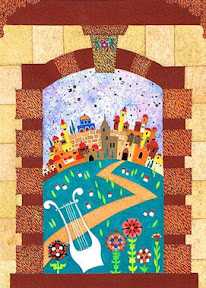

Mariano Akerman, City of the Lord and Peace, c. 1992-5
References
1. The Day of Atonement (Leviticus 16-17) speaks of the Lord’s gracious concern both to deal fully with his people’s sins and to make them fully aware that they stand before him, accepted and covered in respect to all iniquity, transgression, and sin (Leviticus 16:21). On this day, the High Priest would enter the Holy of Holies to atone for the sins of Israel in order to avert the holy wrath of God for the sins of the past year and to remove their sin and its stain from them. Two healthy goats without defect were chosen. They were therefore fit to represent sinless perfection. The first goat was a propitiating sin offering. The High Priest slaughtered this goat, which acted as a substitute for the sinners who deserved a violently bloody death for their many sins. Then the High Priest, acting as the representative and mediator between the sinful people and their holy God, would take the second goat and lay his hands on the animal while confessing the sins of the people. This goat, called the scapegoat, would then be sent away to die in the wilderness away from the sinners, symbolically expiating or removing the sins of the people by taking them away. The sacrifices of the Day were designed to pay for both sin’s penalty and sin’s presence in Israel. The shedding of blood and the sending off of the scapegoat were meant to appease God’s wrath against sin and to cleanse the nation, the priesthood, and even the sanctuary itself from the taint of sin (Leviticus 16:30).
2. For a discussion, see, Ecclesia et Synagoga and Enluminures - (recherche experte, recherche libre, add "synagogue").
3. Munich, Bayerische Staatsbibliothek, clm. 23041. Bibl. In: 800 Jahre Franz von Assisi. Franziskanische Kunst und Kultur des Mittelalters. Katalog der Niederösterreichischen Landesausstellung in Krems-Stein, Minoritenkirche, vom 15. Mai bis 17. Oktober 1982. Redigiert von Harry Kühnel, Hanna Egger, Gerhard Winkler. Katalog des Niederösterreichischen Landesmuseums. N.F. 122. – Wien: Amt der Niederösterreichischen Landesregierung, Kulturabteilung 1982. XXVIII, 775. 8°. Objekt-Nr.: 10.97, S. 619.
4. Elisabeth Vavra: Lebendes Keuz (12.12.2010)
5. "Cette œuvre extrêmement étrange est l’une des plus attachantes de ce musée. Au-delà d’une simple crucifixion, c’est bien l’affirmation de l’avènement d’une nouvelle loi avec la mort du Christ dont il s’agit. A droite, symbole de l’ancienne loi, la synagogue sous la forme d’une vieille femme aux yeux bandés a son bras gauche tranché. A gauche une jeune femme, l’église, est couronnée. Elle est encadrée par les quatre évangélistes. Au-dessus du Christ, un bras muni d’une clé donne l’accès à la Jérusalem céleste. Au registre inférieur, à droite se trouve les limbes et l’enfer dont la limite est figurée par un diable noir enchaîné à la croix. Au pied de celle-ci se trouve un squelette, celui d’Adam et en dessous, une série de personnages dont Noé avec l’arche et le roi David couronné." Musées de Bourgogne
6. "La Chiesa di Cristo scopre il suo legame con l'ebraismo scrutando il proprio mistero. La religione ebraica non ci è estrinseca, ma, in un certo qual modo, è intrinseca alla nostra religione. Abbiamo quindi verso di essa dei rapporti che non abbiamo con nessun'altra religione. Siete i nostri fratelli prediletti e, in un certo modo, si potrebbe dire i nostri fratelli maggiori... Le vie aperte alla nostra collaborazione, alla luce della comune eredità tratta dalla Legge e dai profeti, sono varie e importanti. Vogliamo ricordare anzitutto una collaborazione in favore dell'uomo, della sua vita dal concepimento fino alla morte naturale, della sua dignità, della sua libertà, dei suoi diritti. Vi è, più in generale, il problema morale, il grande campo dell'etica individuale e sociale. In una società spesso smarrita nell'agnosticismo e nell'individualismo e che soffre le amare conseguenze dell'egoismo e della violenza, ebrei e cristiani sono depositari e testimoni di un'etica segnata dai dieci Comandamenti, nella cui osservanza l'uomo trova la sua verità e libertà."
Appendix. On the dychotomy Sol and Luna, see Biblioteca Pleyades. On Disputa as interreligious dialog, see Dionysiana.
2. For a discussion, see, Ecclesia et Synagoga and Enluminures - (recherche experte, recherche libre, add "synagogue").
3. Munich, Bayerische Staatsbibliothek, clm. 23041. Bibl. In: 800 Jahre Franz von Assisi. Franziskanische Kunst und Kultur des Mittelalters. Katalog der Niederösterreichischen Landesausstellung in Krems-Stein, Minoritenkirche, vom 15. Mai bis 17. Oktober 1982. Redigiert von Harry Kühnel, Hanna Egger, Gerhard Winkler. Katalog des Niederösterreichischen Landesmuseums. N.F. 122. – Wien: Amt der Niederösterreichischen Landesregierung, Kulturabteilung 1982. XXVIII, 775. 8°. Objekt-Nr.: 10.97, S. 619.
4. Elisabeth Vavra: Lebendes Keuz (12.12.2010)
5. "Cette œuvre extrêmement étrange est l’une des plus attachantes de ce musée. Au-delà d’une simple crucifixion, c’est bien l’affirmation de l’avènement d’une nouvelle loi avec la mort du Christ dont il s’agit. A droite, symbole de l’ancienne loi, la synagogue sous la forme d’une vieille femme aux yeux bandés a son bras gauche tranché. A gauche une jeune femme, l’église, est couronnée. Elle est encadrée par les quatre évangélistes. Au-dessus du Christ, un bras muni d’une clé donne l’accès à la Jérusalem céleste. Au registre inférieur, à droite se trouve les limbes et l’enfer dont la limite est figurée par un diable noir enchaîné à la croix. Au pied de celle-ci se trouve un squelette, celui d’Adam et en dessous, une série de personnages dont Noé avec l’arche et le roi David couronné." Musées de Bourgogne
6. "La Chiesa di Cristo scopre il suo legame con l'ebraismo scrutando il proprio mistero. La religione ebraica non ci è estrinseca, ma, in un certo qual modo, è intrinseca alla nostra religione. Abbiamo quindi verso di essa dei rapporti che non abbiamo con nessun'altra religione. Siete i nostri fratelli prediletti e, in un certo modo, si potrebbe dire i nostri fratelli maggiori... Le vie aperte alla nostra collaborazione, alla luce della comune eredità tratta dalla Legge e dai profeti, sono varie e importanti. Vogliamo ricordare anzitutto una collaborazione in favore dell'uomo, della sua vita dal concepimento fino alla morte naturale, della sua dignità, della sua libertà, dei suoi diritti. Vi è, più in generale, il problema morale, il grande campo dell'etica individuale e sociale. In una società spesso smarrita nell'agnosticismo e nell'individualismo e che soffre le amare conseguenze dell'egoismo e della violenza, ebrei e cristiani sono depositari e testimoni di un'etica segnata dai dieci Comandamenti, nella cui osservanza l'uomo trova la sua verità e libertà."
Appendix. On the dychotomy Sol and Luna, see Biblioteca Pleyades. On Disputa as interreligious dialog, see Dionysiana.
Kris Kuksi, A Heroic Abduction, mixed media assemblage, 2010
